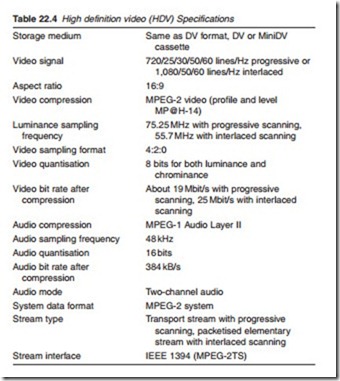Other DV formats: DVCAM
Sony’s DVCAM is a semi-professional variant of the DV standard that uses the same cassettes as DV and MiniDV, but transports the tape 50% faster. This leads to a higher track width of 15 1m. Video and audio encoding is the same as regular DV, namely MPEG-2 intra-frame and VLC. However, the greater track width lowers the chances of dropout errors. All DVCAM recorders and cameras can play back DV material. DVCAM tapes have a shorter recording time than DV of almost third.
DVCPRO (professional)
Specifically created by Panasonic for the professional end of the market, the DVCPRO family is directed towards electronic news gathering (ENG) use. It provides better linear editing capabilities and robustness. It has a track width of 18 J.m and Metal Particle instead of Metal Evaporated tape with a longitudinal analogue audio cue track. Audio is only available in the 16 bit/48 kHz variant and there is no EP mode. DVCPRO uses 4:1:1 colour sampling structure for both NTSC and PAL. Apart from that, standard DVCPRO is otherwise identical to DV.
DVCPRO is normally referred to as DVCPRO25 to distinguish it from the high-value EGN DVCPRO50 which doubles the coded video bitrate from 25 Mb/s to 50 Mb/s, and uses 4:2:2 sampling structure instead of 4:1:1.
DVCPRO HD, also known as DVCPRO100, uses four parallel codecs and a coded video bitrate of approximately 100 Mbps, depending on the format. DVCPRO HD is also 4:2:2. DVCPRO HD downsamples native HD (1280 X 720p and 1920 X 1080i) signals to a lower resolution as follows: 1280 X 720p downsampled to 960 X 720p and 1920 X 1080i downsampled to 1280 X 1080i for NTSC frame rate and 1440 X 1080i for PAL frame rates. This is a common technique, utilised in most tape-based HD formats such as HDCam and HDV to increase the compression ratio to approximately 6.8. To maintain compatibility, DVCPRO100 equipment internally down- samples video during recording, and subsequently upsamples video dur- ing playback. A camcorder using a special variable-frame rate (from 4 to 60 frame/s) variant of DVCPRO HD called VariCam is also available. All these variants are backward compatible but not forward compatible. There is also a DVCPRO HD EX format, which runs the tape at slower speed, result- ing in twice as long recording times.
DVCPRO cassettes are always labelled with a pair of run times, the smaller of the two being the capacity for DVCPRO50. The colour of the lid indicates the format: DVCPRO tapes have a yellow lid, longer “L” tapes made especially for DVCPRO50 have a blue lid and DVCPRO HD tapes have a red lid. The formulation of the tape is the same, and the tapes are interchangeable between formats. The running time of each tape is 1 X for DVCPRO, 2 X for DVCPRO 50, 2 X for DVCPRO HD EX and 4 X for DVCPRO HD, since the tape speed changes between formats. Thus a tape made 126 min for DVCPRO will last approximately 32 min in DVCPRO HD.
A more recent high-definition magnetic tape format is high-definition video (HDV) introduced in 2003. HDV is high-definition, wide screen ver- sion of the DV magnetic tape format. Like DV, HDV recording stores data on the same DV and MiniDV tapes as SD camcorders.
The HDV codec is based on MPEG-2 video compression employing both intra-frame (spatial DCT) and inter-frame (temporal) techniques. As a result of the inter-frame compression, HDV frames vary in size depend- ing on whether they are I, P or B frames. HDV is native 16:9 using 4:2:0 sampling, recording YCbCr frames in 1280 X 720p, 1980 X 1080i or 1980 X 1080p resolutions at frame rates of 60i 30p, 50i or 25p. All HDV variants record to existing standard DV format DVCs, the most popular form fac- tor of which is the Mini-DV shell. The transport stream interface conforms to IEEE 1394 (FireWire). The HDV specifications are listed in Table 22.4
